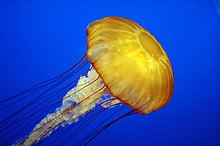
A | B | C | D | E | F | G | H | CH | I | J | K | L | M | N | O | P | Q | R | S | T | U | V | W | X | Y | Z | 0 | 1 | 2 | 3 | 4 | 5 | 6 | 7 | 8 | 9
| Jellyfish | |
|---|---|

| |
| Pacific sea nettle (Chrysaora fuscescens) | |
| Scientific classification | |
| Domain: | Eukaryota |
| Kingdom: | Animalia |
| Phylum: | Cnidaria |
| Subphylum: | Medusozoa |
| Groups included | |
| Cladistically included but traditionally excluded taxa | |
Jellyfish, also known as sea jellies, are the medusa-phase of certain gelatinous members of the subphylum Medusozoa, which is a major part of the phylum Cnidaria.
Jellyfish are mainly free-swimming marine animals with umbrella-shaped bells and trailing tentacles, although a few are anchored to the seabed by stalks rather than being mobile. The bell can pulsate to provide propulsion for efficient locomotion. The tentacles are armed with stinging cells and may be used to capture prey and defend against predators. Jellyfish have a complex life cycle. The medusa is normally the sexual phase, which produces planula larvae. These then disperse widely and enter a sedentary polyp phase which may include asexual budding before reaching sexual maturity.
Jellyfish are found all over the world, from surface waters to the deep sea. Scyphozoans (the "true jellyfish") are exclusively marine, but some hydrozoans with a similar appearance live in freshwater. Large, often colorful, jellyfish are common in coastal zones worldwide. The medusae of most species are fast-growing, and mature within a few months then die soon after breeding, but the polyp stage, attached to the seabed, may be much more long-lived. Jellyfish have been in existence for at least 500 million years,[1] and possibly 700 million years or more, making them the oldest multi-organ animal group.[2]
Jellyfish are eaten by humans in certain cultures. They are considered a delicacy in some Asian countries, where species in the Rhizostomeae order are pressed and salted to remove excess water. Australian researchers have described them as a "perfect food": sustainable and protein-rich but relatively low in food energy.[3]
They are also used in cell and molecular biology research, especially the green fluorescent protein used by some species for bioluminescence. This protein has been adapted as a fluorescent reporter for inserted genes and has had a large impact on fluorescence microscopy.
The stinging cells used by jellyfish to subdue their prey can injure humans. Thousands of swimmers worldwide are stung every year, with effects ranging from mild discomfort to serious injury or even death. When conditions are favourable, jellyfish can form vast swarms, which can be responsible for damage to fishing gear by filling fishing nets, and sometimes clog the cooling systems of power and desalination plants which draw their water from the sea.
Names
The name jellyfish, in use since 1796,[4] has traditionally been applied to medusae and all similar animals including the comb jellies (ctenophores, another phylum).[5][6] The term jellies or sea jellies is more recent, having been introduced by public aquaria in an effort to avoid use of the word "fish" with its modern connotation of an animal with a backbone, though shellfish, cuttlefish and starfish are not vertebrates either.[7][8] In scientific literature, "jelly" and "jellyfish" have been used interchangeably.[9][10] Many sources refer to only scyphozoans as "true jellyfish".[11]
A group of jellyfish is called a "smack"[12] or a "smuck".[13]
Mapping to taxonomic groups

Phylogeny
Definition
The term jellyfish broadly corresponds to medusae,[4] that is, a life-cycle stage in the Medusozoa. The American evolutionary biologist Paulyn Cartwright gives the following general definition:
Typically, medusozoan cnidarians have a pelagic, predatory jellyfish stage in their life cycle; staurozoans are the exceptions .[14]
The Merriam-Webster dictionary defines jellyfish as follows:
A free-swimming marine coelenterate that is the sexually reproducing form of a hydrozoan or scyphozoan and has a nearly transparent saucer-shaped body and extensible marginal tentacles studded with stinging cells.[15]
Given that jellyfish is a common name, its mapping to biological groups is inexact. Some authorities have called the comb jellies[16] and certain salps[16] jellyfish, though other authorities state that neither of these are jellyfish, which they consider should be limited to certain groups within the medusozoa.[17][18]
The non-medusozoan clades called jellyfish by some but not all authorities (both agreeing and disagreeing citations are given in each case) are indicated with "???" on the following cladogram of the animal kingdom:
| Animalia |
| ||||||||||||||||||
Medusozoan jellyfish
Jellyfish are not a clade, as they include most of the Medusozoa, barring some of the Hydrozoa.[19][20] The medusozoan groups included by authorities are indicated on the following phylogenetic tree by the presence of citations. Names of included jellyfish, in English where possible, are shown in boldface; the presence of a named and cited example indicates that at least that species within its group has been called a jellyfish.









